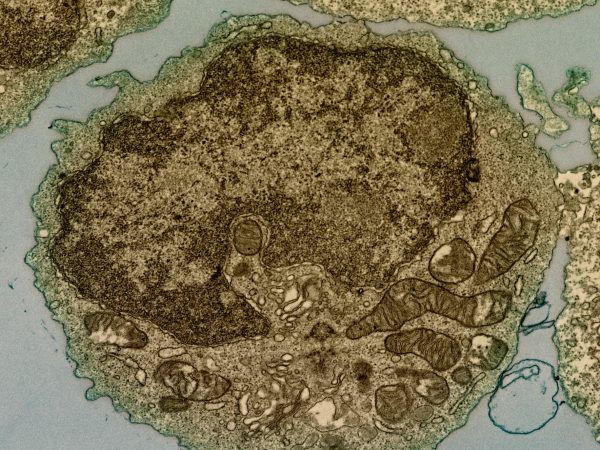Examining Diverse Uses for Liquid Biopsies
Circulating tumor DNA (ctDNA) was first detected over 30 years ago, but its potential uses for cancer diagnosis and treatment are only recently being extensively explored. An emerging method known as liquid biopsy examines ctDNA, cell-free DNA (cfDNA), or circulating tumor cells in blood plasma samples to learn about the patient’s cancer without needing to resect tissue from the tumor itself, as is typically required in traditional diagnostic and staging methods. Liquid biopsy could, therefore, provide a minimally invasive technique to detect and characterize cancer and to monitor its response to treatment.
Recent advances in sequencing technologies have led to greater sensitivity for the detection of mutations in ctDNA or cfDNA during liquid biopsy. Furthermore, research has revealed that changes in DNA levels or sequence correlate with the cancer’s stage, risk of recurrence, and risk of progression, raising the possibility that liquid biopsy could be used to determine these factors in the clinic.
Ongoing research into the uses of liquid biopsy were presented at the AACR Special Conference on Advances in Liquid Biopsies, held last month in Miami. Topics included detection of early-stage cancer and minimal residual disease, genotyping, monitoring of advanced disease and resistance, emerging technologies, and the use of alternative biological samples for liquid biopsy.
Here, we highlight five studies presented at the meeting that demonstrate the diverse uses for liquid biopsy.
biomarkers for early detection of ovarian cancer
Patients diagnosed with late-stage high-grade serous ovarian carcinoma (HGSOC) have a five-year survival rate below 40 percent, compared to approximately 90 percent for those diagnosed with stage I disease. Unfortunately, most patients are diagnosed only after the disease has advanced to a late stage, due in part to the lack of reliable early screening or diagnostic tests.
DNA methylation is a chemical modification of DNA that influences which genes are activated. Changes in DNA methylation can cause cancer by turning genes that regulate cell growth on or off. Therefore, DNA methylation patterns can differ between cancer cells and normal cells.
A study presented by Ben Yi Tew, PhD, a postdoctoral fellow at the University of Southern California, sought to identify tumor-specific aberrant DNA methylation sites that could be used to detect early-stage HGSOC in circulating tumor DNA.

Tew and colleagues first analyzed samples from both tumor and normal tissues to identify genomic sites of tumor-specific DNA methylation. Using reduced representation bisulfite sequencing, they identified 10,927 regions of the genome that were differentially methylated between stage I HGSOC and normal fallopian tube tissue samples. They then focused on the 35 genomic regions that could best distinguish between HGSOC and normal tissue. They examined these in circulating cell-free DNA (cfDNA) obtained from a separate cohort of 61 individuals with stage I-III HGSOC and 21 individuals with benign ovarian masses. Twenty of the 35 regions were able to distinguish between HGSOC and benign tumors in cfDNA with high sensitivity and specificity.
“The biomarkers we identified from tissue samples also accurately predicted ovarian cancer from plasma cfDNA,” said Tew. “With further validation, these novel biomarkers and the assay we developed could potentially be used as a noninvasive test for early detection for HGSOC.”
Predicting survival for multiple myeloma
Current prognostic markers for patients with multiple myeloma are either unreliable or require invasive bone marrow biopsies. Aberrant DNA methylation has been associated with poor prognosis and low survival rates in patients with multiple myeloma, and 5-hydroxymethylcytosine (5hmC)-modified genes in circulating cfDNA were associated with relapse or death in patients with diffuse large B-cell lymphoma, another lymphoproliferative disorder. However, the prognostic significance of 5hmC in cfDNA for multiple myeloma has not been investigated.
Brian Chiu, PhD, associate professor of public health sciences at the University of Chicago, presented results from a study examining the prognostic significance of 5hmC for multiple myeloma. Patients with newly diagnosed multiple myeloma were enrolled in the study beginning in 2010 and followed through December 2017. Blood samples were collected from patients at the time of diagnosis, and mortality was determined using medical records and the National Death Index. Chiu and colleagues identified sites of 5hmC-modification in cfDNA isolated from blood plasma samples and found that the 5hmC-modified genes were associated with overall survival after diagnosis.

The authors focused on a preliminary eight-gene panel to compute a weighted prognostic score that was based on 5hmC enrichment. Patients with high weighted prognostic scores had 10.3-times worse overall survival compared with patients with a low weighted prognostic score. The weighted prognostic scores remained significantly associated with overall survival after controlling for age, gender, and standard prognostic indices, such as high-risk cytogenetics, β2-microglobulin, and lactate dehydrogenase levels. The prediction accuracy of the 5hmC-based weighted prognostic score was found to outperform standard prognostic indices.
“Our preliminary findings suggest that 5hmC signatures in cfDNA have the potential to be a clinically convenient and minimally invasive prognostic approach for the management of multiple myeloma,” said Chiu. “Our findings, if validated in a larger independent patient population, which we are currently undertaking, could impact treatment outcomes of multiple myeloma.”
clonal evolution in metastatic breast cancer
Liquid biopsy allows for repeated genomic profiling of circulating tumor DNA (ctDNA) over narrow time frames, which can provide information about tumor genomic shifts. In a study presented by Daniel Stover, MD, assistant professor at the Ohio State University Comprehensive Cancer Center, ctDNA samples were collected over narrow time frames from seven patients with metastatic triple-negative breast cancer (mTNBC) and deeply analyzed for changes in tumor fraction and existence of alterations in the tumor DNA.

All seven patients in this study were enrolled in the same clinical trial and thus received uniform treatment with the multikinase inhibitor cabozantinib. Blood plasma samples were collected at enrollment and every 7 to 21 days thereafter for as long as each patient remained on treatment. Forty-two samples were analyzed in total and underwent multiple ctDNA sequencing approaches. Stover reported that the tumor fraction of ctDNA changed significantly within as few as six days after initiating treatment, and that these changes did not necessarily align with RECIST imaging measurements.
Statistical modeling demonstrated diverse clonal architectures and dynamics over the course of the treatment, and several somatic alterations emerged at late time points of treatment. These alterations included changes in coding regions, proximal regulatory sites, introns of key drug targets, and predicted tumor neoantigens.
“A major potential benefit of liquid biopsy is the opportunity for repeated tumor genomic sampling,” said Stover. “Our study supports prior work suggesting that tumor fraction of ctDNA can change over narrow time windows. Furthermore, we show evidence of tumor evolution over just weeks.”
Stover and colleagues propose that detection of tumor evolution during treatment could provide real-time insight and impact clinical decision-making.
a sequencing assay for noninvasive somatic mutation profiling
The Memorial Sloan Kettering Analysis of Circulating cfDNA to Evaluate Somatic Status (MSK-ACCESS) next-generation sequencing assay is designed to detect ultra-low frequency somatic variants in 129 genes from cell-free DNA obtained from patient plasma samples. MSK-ACCESS was recently validated and approved for clinical use by the New York State Department of Health.

A. Rose Brannon, PhD, associate director of clinical bioinformatics at the Memorial Sloan Kettering Cancer Center, presented results from the validation and clinical implementation of MSK-ACCESS. The validation demonstrated that MSK-ACCESS identified mutations with 93 percent accuracy, 99 percent precision, and 100 percent sensitivity. MSK-ACCESS detected copy number alterations, gene fusions, and microsatellite instability (MSI) status. After receiving approval for clinical use, Brannon reported that 500 cfDNA samples and paired time-matched white blood cells, mostly from patients with lung or prostate cancers, have been clinically and prospectively analyzed thus far.
By comparing a patient’s cfDNA samples with time-matched white blood cell samples, MSK-ACCESS was able to more confidently identify true somatic alterations and exclude cases of germline or clonal hematopoiesis variants, according to Brannon. A driver variant detected by MSK-ACCESS in lung cancer patients was also detected by the previously approved tumor tissue-based test, MSK-IMPACT, in 91 percent of the samples that were analyzed by both assays. Ongoing analyses aim to identify targetable variants in patients where analyses of tissue samples are not possible and to detect minimal residual disease after surgery.
“The development of this in-house assay allows us to provide a less invasive diagnostic and monitoring tool, integrate the results with previous tumor-derived sequencing results, and provide a more comprehensive clinical picture for patient care,” said Brannon.
IMPROVING THE DETECTION OF prostate cancer
Approximately half of all prostate cancers detected by prostate-specific antigen (PSA) screening are unlikely to ever surface clinically. Detection of these indolent cancers can result in unnecessary treatment, which can carry more risks than benefits for the patient. As a result, there is a need for a noninvasive test to identify clinically significant or metastatic prostate cancer prior to a prostate biopsy.

Extracellular vesicles (EVs) are used by cancer cells to communicate with each other and surrounding stromal cells. Identifying the messages transmitted via EVs is a method to detect and monitor cancer progression. Desmond Pink, PhD – a senior member in the lab of John Lewis, PhD, chair of prostate cancer research at the University of Alberta – presented results from a prospective clinical validation of ClarityDX Prostate, a microflow cytometry-based test that quantifies EVs in patient blood samples and uses machine learning to characterize biological signatures within the EVs to predict clinically significant prostate cancer.

The prospective clinical validation study enrolled 377 Albertan men who were recommended to receive a prostate biopsy based on their family history and results from a PSA test or digital rectal exam. The average area under the curve (AUC) for ClarityDX Prostate was significantly higher than PSA testing alone (AUC 0.83 vs. 0.58), indicating that ClarityDX Prostate was a better predictor of prostate cancer. ClarityDX Prostate had a 56 percent specificity for aggressive prostate cancer, compared to 17 percent specificity with PSA testing alone. An ongoing study by Lewis and colleagues will enroll up to 2,800 men to assess the value of performing ClarityDX Prostate as a reflex test in men with PSA levels greater than 3 ng/mL.
“Upon confirmation in a larger study, incorporating the ClarityDX Prostate blood test into routine prostate cancer screening could reduce the number of unnecessary biopsies by up to 40 percent and improve the detection of clinically significant prostate cancer,” said Lewis.



